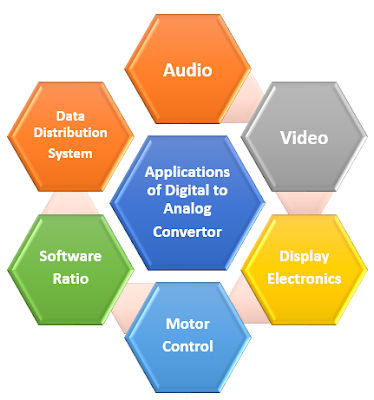Digital to Analog Converter (DAC)
DAC stand for Digital to Analog Converter . It is
a system that converts a digital
signal into an analog signal. Example, When
you hear digital recordings, you’re actually listening to an analog signal that
was converted from digital by a DAC.
DACs
are commonly used in music
players to convert digital data streams into analog audio
signals. They are also used in televisions and mobile phones to convert
digital video data into analog video signals which connect to the screen
drivers to display monochrome or color images.
Any time a signal is
converted from one format to another, there is a potential loss of quality.
Therefore, it is important to have a high-quality DAC whether you are
converting audio or video signals.
Applications
1.
Audio :- The most common use for a DAC is to convert digital audio to
an analog signal. This conversion typically takes place in the sound card, which has a
built-in DAC. The digital signal, which is basically a stream of ones and
zeros, is transformed into an analog signal that might take the form of an
electrical charge. This electrical charge is recognized by most speaker inputs
and therefore can be output to a speaker system. The
audio DAC is a low-frequency, high-resolution type.
2.
Video :- DACs are also used for converting video signals. Previously,
most video displays, such as TVs and computer monitors used analog
inputs. But now from the last couple of years, digital displays with DVI and HDMI connections
have become common. Therefore, in order for a computer to output to an analog
display, the digital video signal must be converted to an analog signal. This
is why all video cards with an
analog output (such as a VGA connection)
also include a DAC. The video DAC is a
high-frequency low- to medium-resolution type.
3. Display Electronics :- The
graphic controller will typically use a lookup table to generate data signals
sent to a video DAC for analog outputs such as Red, Green, Blue (RGB) signals
to drive a display.
4.
Motor
Control :- Many motor controls require voltage control signals,
and a DAC is ideal for this application which may be driven by a processor or
controller.
5.
Software
Radio :- A DAC is used with a Digital Signal Processor (DSP) to convert a signal
into analog for transmission in the mixer circuit, and then to the radio’s power amplifier and
transmitter.
6. Data
Distribution System :- Many industrial and factory lines require multiple programmable voltage
sources, and this can be generated by a bank of DACs that are multiplexed. The
use of a DAC allows the dynamic change of voltages during operation of a
system.
Types
of DAC
1.
Pulse-width modulator
2.
Oversampling DAC
3.
Binary-weighted DAC
4.
R-2R ladder DAC
5.
Cyclic DAC
6.
Thermometer-coded DAC
7.
Hybrid DAC



Comments
Post a Comment